Abstract
The opiate analgesic propoxyphene produces cardiac toxicity when taken in overdose. We recently observed a patient with propoxyphene overdose in whom marked QRS widening was reversed by lidocaine. The reversal is apparently paradoxical as both agents block the inward sodium current (INa). We examined possible mechanisms of the reversal by measuring INa in rabbit atrial myocytes during exposure to propoxyphene and the combination of propoxyphene and lidocaine (60 and 80 microM, respectively). Propoxyphene caused use-dependent block of INa during pulse train stimulation. Block recovered slowly with time constants of 20.8 +/- 3.9 s. Block during lidocaine exposure recovered with time constants of 2-3 s. During exposure to the mixture, block recovered as a double exponential. The half time for recovery during exposure to the mixture was 1.6 +/- .9 s compared with a half-time of 14.3 +/- 2.9 s during exposure to propoxyphene alone. During pulse train stimulation, less steady-state block was observed during exposure to the mixture than during exposure to propoxyphene alone when the interval between pulses was greater than 0.95 s. Both drugs compete for a common receptor during the polarizing phase. The more rapid dissociation of lidocaine during the recovery period leads to less block during the mixture than during exposure to propoxyphene alone. The experiments suggest a mechanism for reversal of the cardiac toxicity of drugs which have slow unbinding kinetics.
Full text
PDF
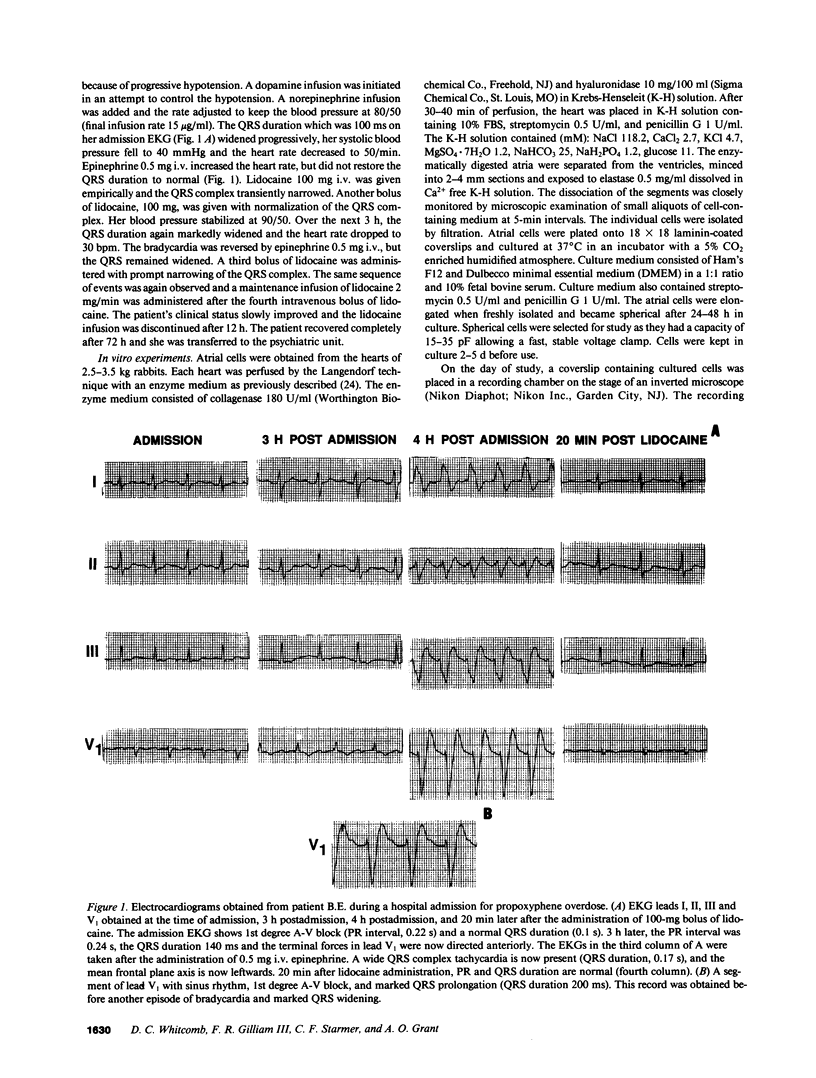

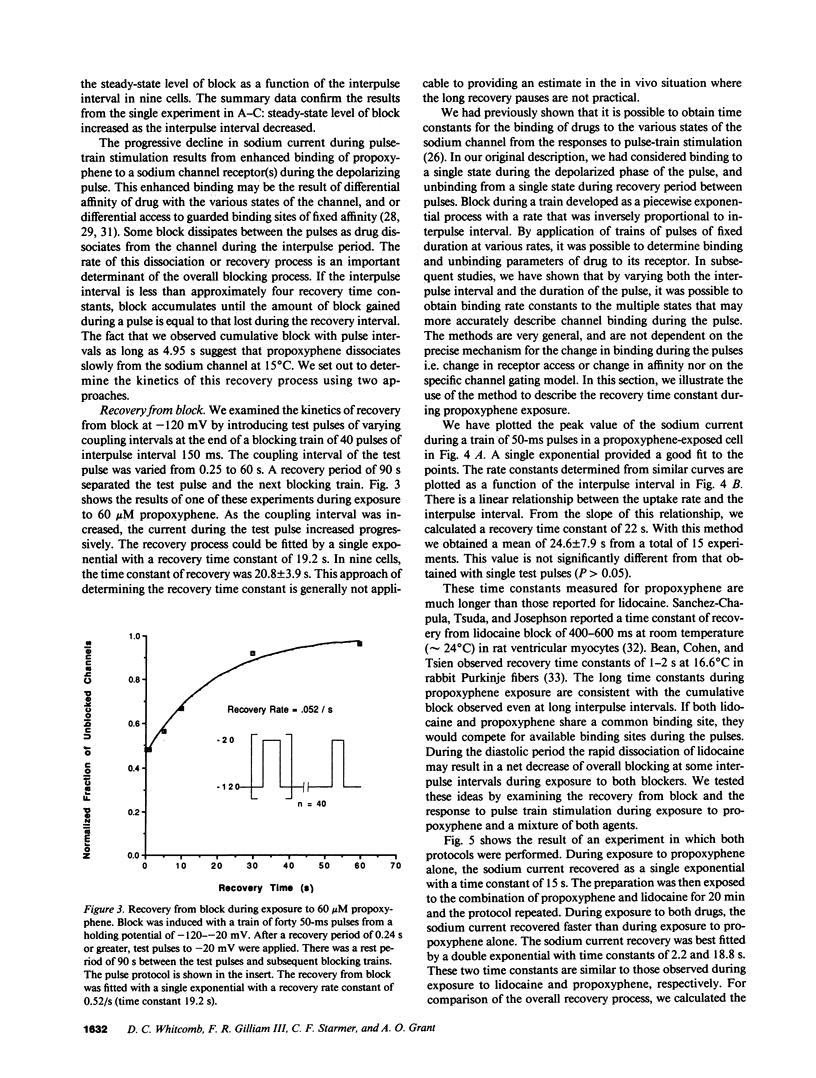
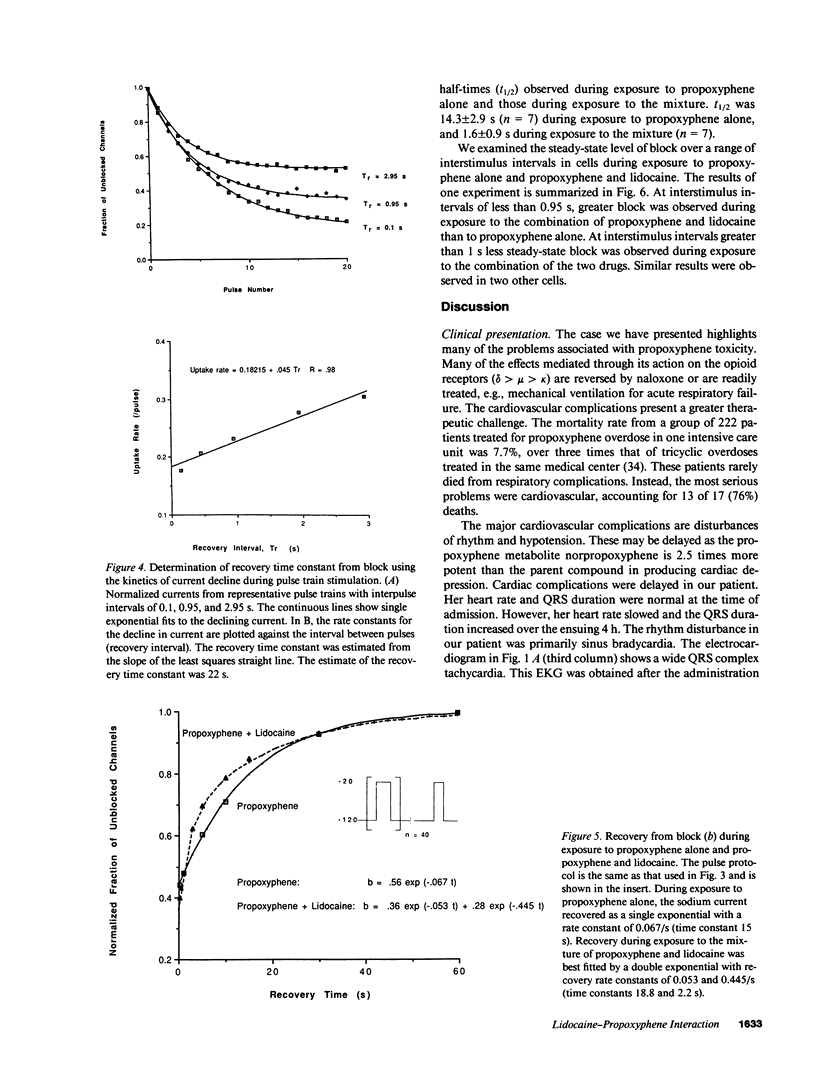
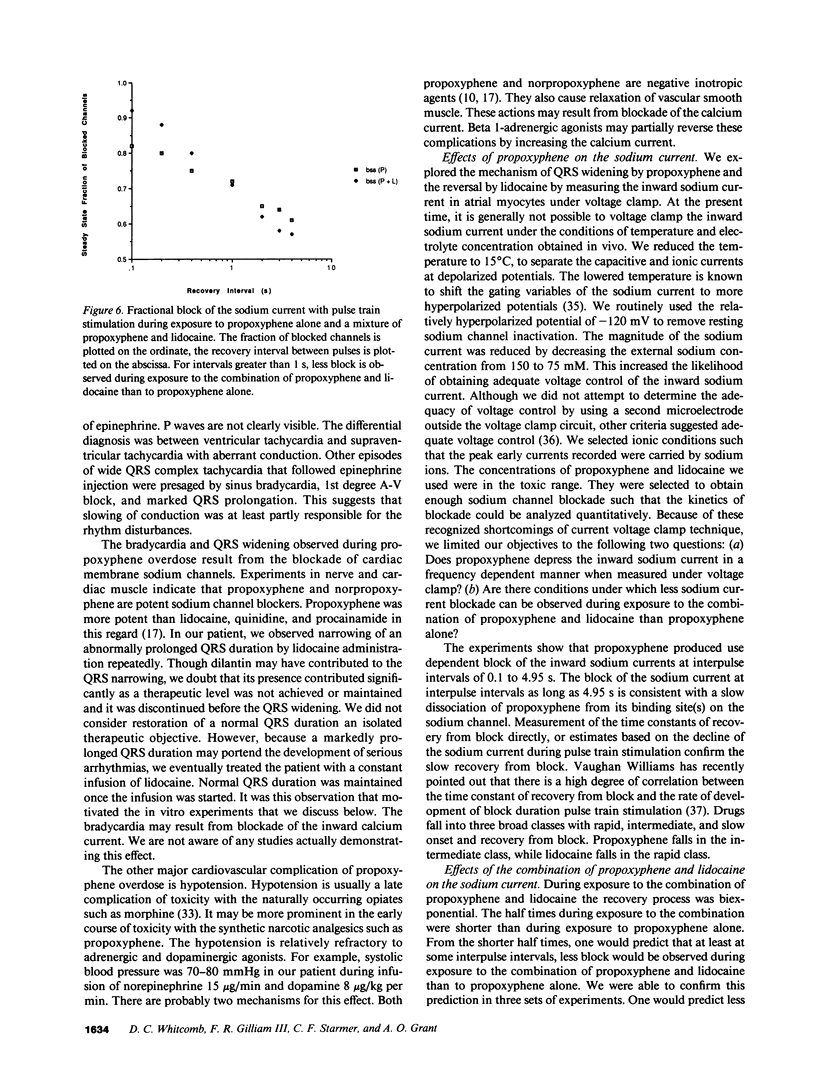
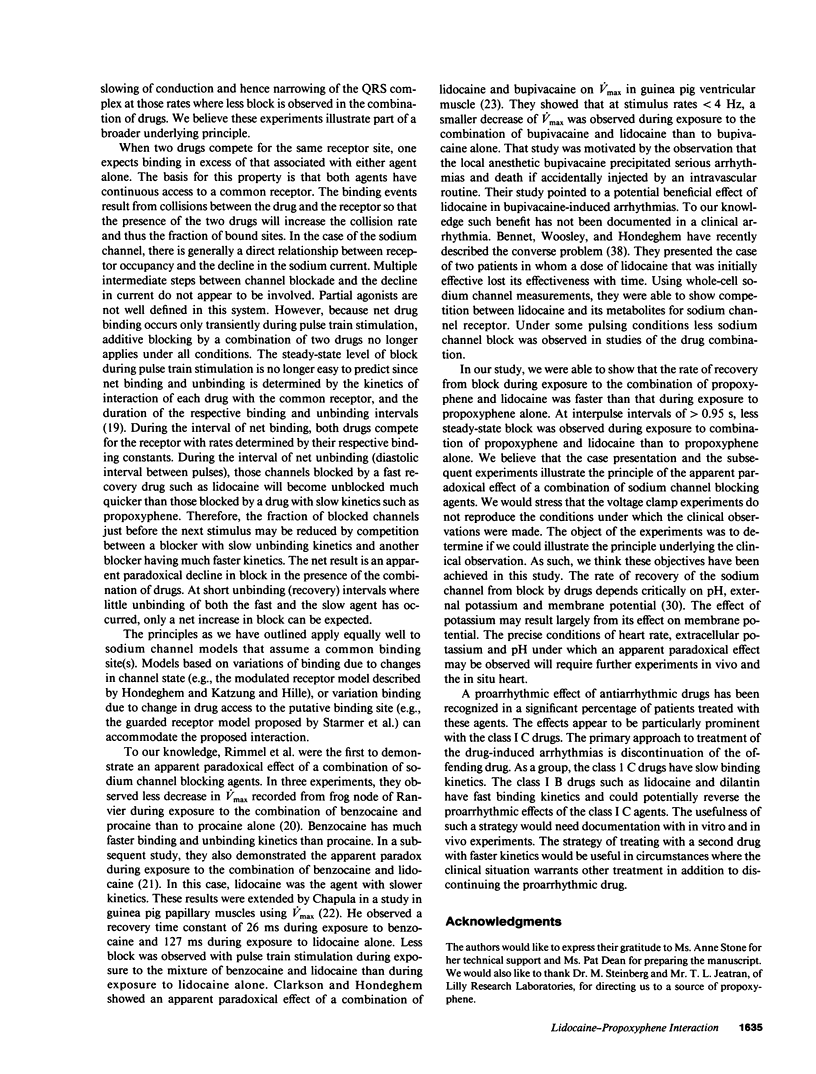
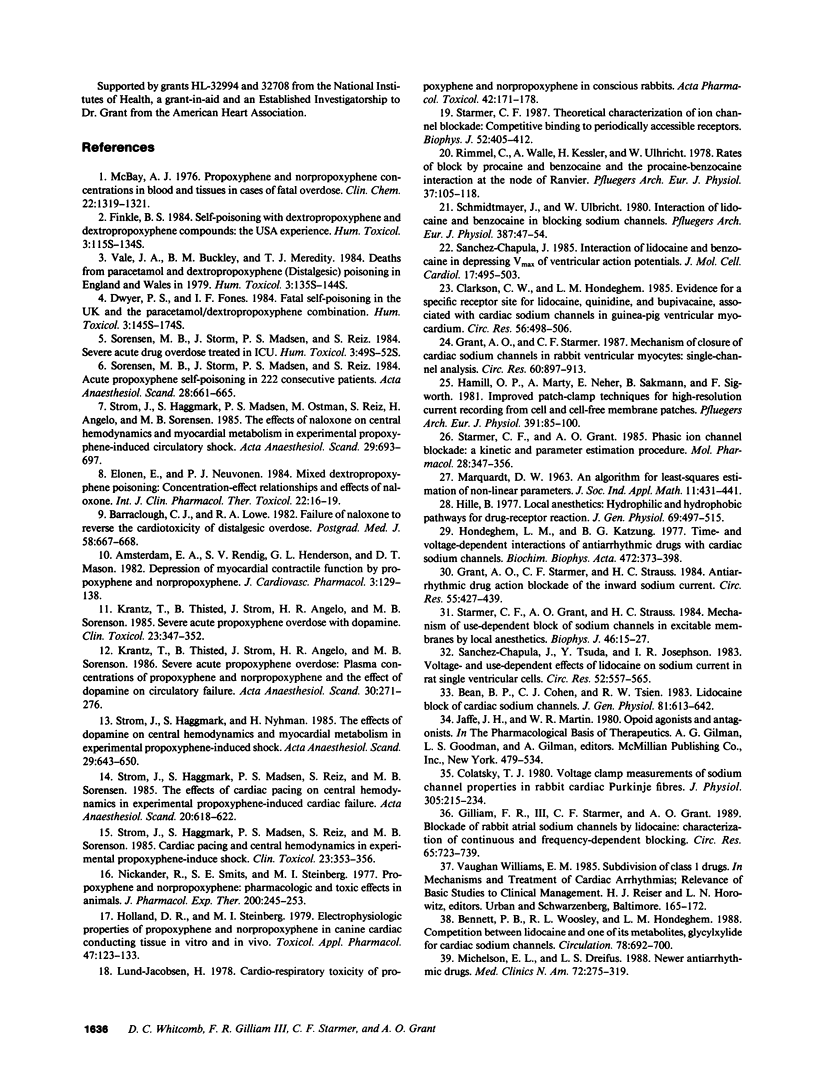
Images in this article
Selected References
These references are in PubMed. This may not be the complete list of references from this article.
- Amsterdam E. A., Rendig S. V., Henderson G. L., Mason D. T. Depression of myocardial contractile function by propoxyphene and norpropoxyphene. J Cardiovasc Pharmacol. 1981 Jan-Feb;3(1):129–138. doi: 10.1097/00005344-198101000-00011. [DOI] [PubMed] [Google Scholar]
- Barraclough C. J., Lowe R. A. Failure of naloxone to reverse the cardiotoxocity of Distalgesic overdose. Postgrad Med J. 1982 Oct;58(684):667–668. doi: 10.1136/pgmj.58.684.667. [DOI] [PMC free article] [PubMed] [Google Scholar]
- Bean B. P., Cohen C. J., Tsien R. W. Lidocaine block of cardiac sodium channels. J Gen Physiol. 1983 May;81(5):613–642. doi: 10.1085/jgp.81.5.613. [DOI] [PMC free article] [PubMed] [Google Scholar]
- Bennett P. B., Woosley R. L., Hondeghem L. M. Competition between lidocaine and one of its metabolites, glycylxylidide, for cardiac sodium channels. Circulation. 1988 Sep;78(3):692–700. doi: 10.1161/01.cir.78.3.692. [DOI] [PubMed] [Google Scholar]
- Bredgaard Sørensen M., Strøm J., Sloth Madsen P., Reiz S. Severe acute drug overdose treated in ICU. Hum Toxicol. 1984 Aug;3 (Suppl):49S–51S. doi: 10.1177/096032718400300106. [DOI] [PubMed] [Google Scholar]
- Chapula J. S. Interaction of lidocaine and benzocaine in depressing Vmax of ventricular action potentials. J Mol Cell Cardiol. 1985 May;17(5):495–503. doi: 10.1016/s0022-2828(85)80054-7. [DOI] [PubMed] [Google Scholar]
- Clarkson C. W., Hondeghem L. M. Evidence for a specific receptor site for lidocaine, quinidine, and bupivacaine associated with cardiac sodium channels in guinea pig ventricular myocardium. Circ Res. 1985 Apr;56(4):496–506. doi: 10.1161/01.res.56.4.496. [DOI] [PubMed] [Google Scholar]
- Colatsky T. J. Voltage clamp measurements of sodium channel properties in rabbit cardiac Purkinje fibres. J Physiol. 1980 Aug;305:215–234. doi: 10.1113/jphysiol.1980.sp013359. [DOI] [PMC free article] [PubMed] [Google Scholar]
- Dwyer P. S., Jones I. F. Fatal self-poisoning in the UK and the paracetamol/dextropropoxyphene combination. Hum Toxicol. 1984 Aug;3 (Suppl):145S–174S. doi: 10.1177/096032718400300115. [DOI] [PubMed] [Google Scholar]
- Elonen E., Neuvonen P. J. Mixed dextropropoxyphene poisoning: concentration-effect relationships and effect of naloxone. Int J Clin Pharmacol Ther Toxicol. 1984 Jan;22(1):16–19. [PubMed] [Google Scholar]
- Finkle B. S. Self-poisoning with dextropropoxyphene and dextropropoxyphene compounds: the USA experience. Hum Toxicol. 1984 Aug;3 (Suppl):115S–134S. doi: 10.1177/096032718400300113. [DOI] [PubMed] [Google Scholar]
- Gilliam F. R., 3rd, Starmer C. F., Grant A. O. Blockade of rabbit atrial sodium channels by lidocaine. Characterization of continuous and frequency-dependent blocking. Circ Res. 1989 Sep;65(3):723–739. doi: 10.1161/01.res.65.3.723. [DOI] [PubMed] [Google Scholar]
- Grant A. O., Starmer C. F. Mechanisms of closure of cardiac sodium channels in rabbit ventricular myocytes: single-channel analysis. Circ Res. 1987 Jun;60(6):897–913. doi: 10.1161/01.res.60.6.897. [DOI] [PubMed] [Google Scholar]
- Grant A. O., Starmer C. F., Strauss H. C. Antiarrhythmic drug action. Blockade of the inward sodium current. Circ Res. 1984 Oct;55(4):427–439. doi: 10.1161/01.res.55.4.427. [DOI] [PubMed] [Google Scholar]
- Hamill O. P., Marty A., Neher E., Sakmann B., Sigworth F. J. Improved patch-clamp techniques for high-resolution current recording from cells and cell-free membrane patches. Pflugers Arch. 1981 Aug;391(2):85–100. doi: 10.1007/BF00656997. [DOI] [PubMed] [Google Scholar]
- Hille B. Local anesthetics: hydrophilic and hydrophobic pathways for the drug-receptor reaction. J Gen Physiol. 1977 Apr;69(4):497–515. doi: 10.1085/jgp.69.4.497. [DOI] [PMC free article] [PubMed] [Google Scholar]
- Holland D. R., Steinberg M. I. Electrophysiologic properties of propoxyphene and norpropoxyphene in canine cardiac conducting tissues in vitro and in vivo. Toxicol Appl Pharmacol. 1979 Jan;47(1):123–133. doi: 10.1016/0041-008x(79)90079-6. [DOI] [PubMed] [Google Scholar]
- Hondeghem L. M., Katzung B. G. Time- and voltage-dependent interactions of antiarrhythmic drugs with cardiac sodium channels. Biochim Biophys Acta. 1977 Nov 14;472(3-4):373–398. doi: 10.1016/0304-4157(77)90003-x. [DOI] [PubMed] [Google Scholar]
- Krantz T., Thisted B., Strøm J., Angelo H. R., Sørensen M. B. Severe acute propoxyphene overdose: plasma concentrations of propoxyphene and norpropoxyphene and the effect of dopamine on circulatory failure. Acta Anaesthesiol Scand. 1986 May;30(4):271–276. doi: 10.1111/j.1399-6576.1986.tb02411.x. [DOI] [PubMed] [Google Scholar]
- Krantz T., Thisted B., Strøm J., Angelo H., Sørensen M. B. Severe, acute propoxyphene overdose treated with dopamine. J Toxicol Clin Toxicol. 1985;23(4-6):347–352. doi: 10.3109/15563658508990643. [DOI] [PubMed] [Google Scholar]
- Lund-Jacobsen H. Cardio-respiratory toxicity of propoxyphene and norpropoxyphene in conscious rabbits. Acta Pharmacol Toxicol (Copenh) 1978 Mar;42(3):171–178. doi: 10.1111/j.1600-0773.1978.tb02187.x. [DOI] [PubMed] [Google Scholar]
- McBay A. J. Propoxyphene and norpropoxyphene concentrations in blood and tissues in cases of fatal overdose. Clin Chem. 1976 Aug;22(8):1319–1321. [PubMed] [Google Scholar]
- Michelson E. L., Dreifus L. S. Newer antiarrhythmic drugs. Med Clin North Am. 1988 Mar;72(2):275–319. doi: 10.1016/s0025-7125(16)30772-6. [DOI] [PubMed] [Google Scholar]
- Nickander R., Smits S. E., Steinberg M. I. Propoxyphene and norpropoxyphene: pharmacologic and toxic effects in animals. J Pharmacol Exp Ther. 1977 Jan;200(1):245–253. [PubMed] [Google Scholar]
- Rimmel C., Walle A., Kessler H., Ulbricht W. Rates of block by procaine and benzocaine and the procaine-benzocaine interaction at the node of Ranvier. Pflugers Arch. 1978 Sep 6;376(2):105–118. doi: 10.1007/BF00581574. [DOI] [PubMed] [Google Scholar]
- Sanchez-Chapula J., Tsuda Y., Josephson I. R. Voltage- and use-dependent effects of lidocaine on sodium current in rat single ventricular cells. Circ Res. 1983 May;52(5):557–565. doi: 10.1161/01.res.52.5.557. [DOI] [PubMed] [Google Scholar]
- Schmidtmayer J., Ulbricht W. Interaction of lidocaine and benzocaine in blocking sodium channels. Pflugers Arch. 1980 Aug;387(1):47–54. doi: 10.1007/BF00580843. [DOI] [PubMed] [Google Scholar]
- Sloth Madsen P., Strøm J., Reiz S., Bredgaard Sørensen M. Acute propoxyphene self-poisoning in 222 consecutive patients. Acta Anaesthesiol Scand. 1984 Dec;28(6):661–665. doi: 10.1111/j.1399-6576.1984.tb02141.x. [DOI] [PubMed] [Google Scholar]
- Starmer C. F., Grant A. O. Phasic ion channel blockade. A kinetic model and parameter estimation procedure. Mol Pharmacol. 1985 Oct;28(4):348–356. [PubMed] [Google Scholar]
- Starmer C. F., Grant A. O., Strauss H. C. Mechanisms of use-dependent block of sodium channels in excitable membranes by local anesthetics. Biophys J. 1984 Jul;46(1):15–27. doi: 10.1016/S0006-3495(84)83994-6. [DOI] [PMC free article] [PubMed] [Google Scholar]
- Starmer C. F. Theoretical characterization of ion channel blockade. Competitive binding to periodically accessible receptors. Biophys J. 1987 Sep;52(3):405–412. doi: 10.1016/S0006-3495(87)83229-0. [DOI] [PMC free article] [PubMed] [Google Scholar]
- Strøm J., Häggmark S., Madsen P. S., Ostman M., Reiz S., Angelo H., Sørensen M. B. The effects of naloxone on central hemodynamics and myocardial metabolism in experimental propoxyphene-induced circulatory shock. Acta Anaesthesiol Scand. 1985 Oct;29(7):693–697. doi: 10.1111/j.1399-6576.1985.tb02282.x. [DOI] [PubMed] [Google Scholar]
- Strøm J., Häggmark S., Madsen P. S., Reiz S., Bredgaard Sørensen M. The effects of cardiac pacing on central hemodynamics in experimental propoxyphene-induced cardiac failure. Acta Anaesthesiol Scand. 1985 Aug;29(6):618–622. doi: 10.1111/j.1399-6576.1985.tb02267.x. [DOI] [PubMed] [Google Scholar]
- Strøm J., Häggmark S., Madsen P. S., Reiz S., Sørensen M. B. Cardiac pacing and central hemodynamics in experimental propoxyphene induced shock. J Toxicol Clin Toxicol. 1985;23(4-6):353–356. doi: 10.3109/15563658508990644. [DOI] [PubMed] [Google Scholar]
- Strøm J., Häggmark S., Nyhman H., Reiz S., Madsen P. S., Angelo H., Bredgaard Sørensen M. The effects of dopamine on central hemodynamics and myocardial metabolism in experimental propoxyphene-induced shock. Acta Anaesthesiol Scand. 1985 Aug;29(6):643–650. doi: 10.1111/j.1399-6576.1985.tb02273.x. [DOI] [PubMed] [Google Scholar]
- Vale J. A., Buckley B. M., Meredith T. J. Deaths from paracetamol and dextropropoxyphene (Distalgesic) poisoning in England and Wales in 1979. Hum Toxicol. 1984 Aug;3 (Suppl):135S–143S. doi: 10.1177/096032718400300114. [DOI] [PubMed] [Google Scholar]







